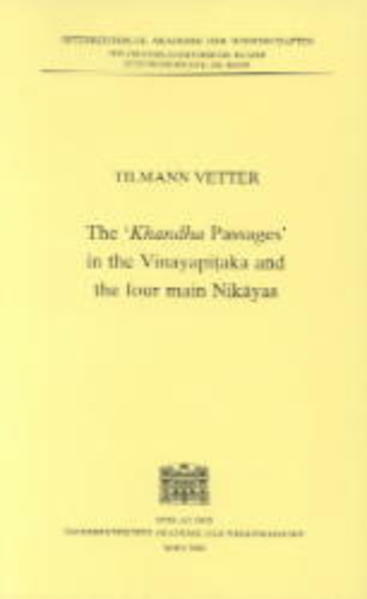Bitte haben Sie einen Moment Geduld, wir legen Ihr Produkt in den Warenkorb.
| Reihe | Sitzungsberichte der philosophisch-historischen Klasse |
|---|---|
| ISBN | 9783700129325 |
| Sprache | Englisch, Deutsch |
| Erscheinungsdatum | 01.01.2000 |
| Genre | Religion, Theologie/Weitere Religionen |
| Verlag | Verlag der österreichischen Akademie der Wissenschaften |
| Lieferzeit | Lieferung in 3-10 Werktagen |
| Herstellerangaben | Anzeigen Verlag der Österreichischen Akademie der Wissenschaften Dr. Ignaz Seipel-Platz 2 | AT-1010 Wien verlag@oeaw.ac.at |
- ✔ kostenlose Lieferung innerhalb Österreichs ab € 35,–
- ✔ über 1,5 Mio. Bücher, DVDs & CDs im Angebot
- ✔ alle FALTER-Produkte und Abos, nur hier!
- ✔ hohe Sicherheit durch SSL-Verschlüsselung (RSA 4096 bit)
- ✔ keine Weitergabe personenbezogener Daten an Dritte
- ✔ als 100% österreichisches Unternehmen liefern wir innerhalb Österreichs mit der Österreichischen Post
This book investigates all passages in the first parts of the Pali canon that refer to the teaching of the five “branches” of a person that should be distanced. 449 passages mentioning the series rupa, vedana, san~n~a, san.khara and vin~n~ana (translated as “body”, “feeling”, “ideation”, “impulses” and “sensation”) or hinting at them by means of the terms upada nakkhandha or khandha are recorded. All passages that are not repetitions are critically edited and translated into English. If the context allows, remarks on their soteriological function are made; if available, parallels in (hybrid) Sanskrit fragments, Chinese and Tibetan translations are referred to or quoted.
The long introduction points to possible historical arrangements of different formulations of this teaching and discusses the meaning of the five terms rupa, etc, with special emphasis on san.khara. Appendix 1 shows where the terms upadanakkhandha or khandha can be found and whether a passage refers to a person that should distance the five items (ca.60% of the passages), or only speaks of distancing without mentioning a person (ca.40%), or denies the existence of a person (1 passage). Appendix 2 quotes, with English translations, the few traces of this teaching in the verse texts of the fifth Nikaya (none in the Suttanipata!). Apendix 3 refers to stereotype formulas and Apendix 4 contains ancient names and terms.
| Reihe | Sitzungsberichte der philosophisch-historischen Klasse |
|---|---|
| ISBN | 9783700129325 |
| Sprache | Englisch, Deutsch |
| Erscheinungsdatum | 01.01.2000 |
| Genre | Religion, Theologie/Weitere Religionen |
| Verlag | Verlag der österreichischen Akademie der Wissenschaften |
| Lieferzeit | Lieferung in 3-10 Werktagen |
| Herstellerangaben | Anzeigen Verlag der Österreichischen Akademie der Wissenschaften Dr. Ignaz Seipel-Platz 2 | AT-1010 Wien verlag@oeaw.ac.at |
- ✔ kostenlose Lieferung innerhalb Österreichs ab € 35,–
- ✔ über 1,5 Mio. Bücher, DVDs & CDs im Angebot
- ✔ alle FALTER-Produkte und Abos, nur hier!
- ✔ hohe Sicherheit durch SSL-Verschlüsselung (RSA 4096 bit)
- ✔ keine Weitergabe personenbezogener Daten an Dritte
- ✔ als 100% österreichisches Unternehmen liefern wir innerhalb Österreichs mit der Österreichischen Post
Wie gefällt Ihnen unser Shop?



